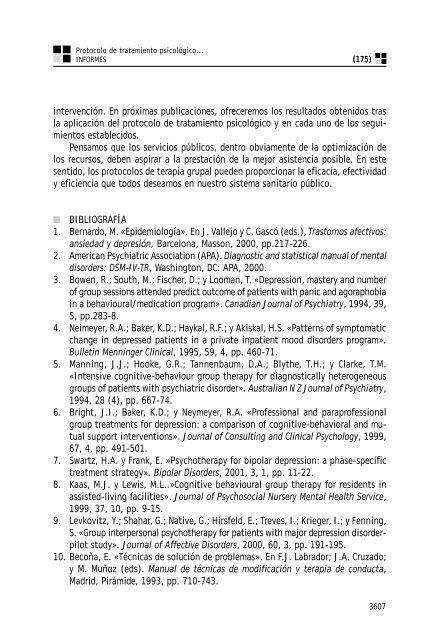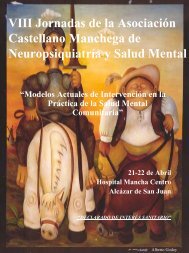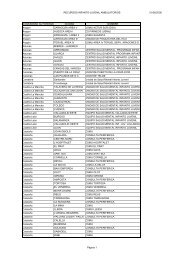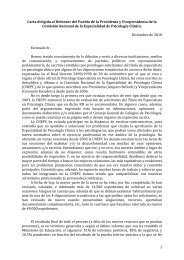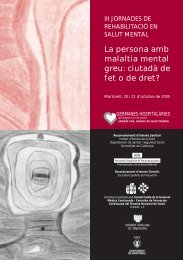(174)Protocolo <strong>de</strong> tratamiento psicológico...INFORMESDISCUSIÓN Y CONCLUSIONESDe acuerdo con Pérez y García (12), hay tres tratamientos psicológicos que tienenmostrada su eficacia en la <strong>de</strong>presión mediante estudios controlados. Éstos son laterapia <strong>de</strong> conducta, la terapia cognitiva y la terapia interpersonal. A<strong>de</strong>más, todasson susceptibles <strong>de</strong> aplicación en grupo, y no sólo como tratamiento en fase agudasino también como continuación, mantenimiento, prevención <strong>de</strong> recaídas yrecurrencias. Según estos autores, la eficacia ha mostrado ser, como mínimo, igual ala eficacia <strong>de</strong> la medicación anti<strong>de</strong>presiva, y tanto en las condiciones menos severascomo en las más severas. Tal como hemos expuesto en la <strong>de</strong>scripción <strong>de</strong> nuestrotratamiento, el protocolo que proponemos incluye los componentes <strong>de</strong> los tres tratamientosque señalan Pérez y García (12).Es evi<strong>de</strong>nte que las terapias psicológicas son susceptibles <strong>de</strong> ser aplicadas engrupo, <strong>de</strong> modo que su eficacia pue<strong>de</strong> multiplicarse haciéndose más eficientes. Laterapia <strong>de</strong> grupo no tiene sólo un interés <strong>de</strong> eficiencia, sino que también es <strong>de</strong>interés para la eficacia. En esta línea, un estudio <strong>de</strong> Echeburúa y otros (13) ha<strong>de</strong>mostrado la viabilidad <strong>de</strong> la terapia <strong>de</strong> grupos en centros <strong>de</strong> salud mental, lo quelos propios autores valoran como un ahorro <strong>de</strong> costes importante.Al igual que ocurre en la población adulta, la aplicación grupal <strong>de</strong>l tratamiento<strong>de</strong> la <strong>de</strong>presión en la infancia y adolescencia es tan eficaz como la individual, pero seobtienen mejores resultados con grupos <strong>de</strong> terapia pequeños (14). En este sentido,Oei y Kazmierczak (15) estudiaron los factores que se relacionaban con el abandono<strong>de</strong> una terapia cognitivo-conductual grupal en pacientes con trastornos <strong>de</strong>l estado<strong>de</strong> ánimo. Encontraron que los sujetos que abandonaban participaban significativamentemenos en el grupo que los que finalizaban el tratamiento. Lógicamente, elmayor número <strong>de</strong> participantes, aunque proporciona riqueza al grupo, dificulta lasposibilida<strong>de</strong>s <strong>de</strong> participación <strong>de</strong> cada miembro.Tal como se recoge en la introducción, existen estudios que han <strong>de</strong>mostrado laeficacia <strong>de</strong> las distintas técnicas <strong>de</strong> tratamiento que incluimos en nuestro protocolo.Sin embargo, no hemos encontrado trabajos que hayan integrado en un mismo protocolo<strong>de</strong> evaluación y tratamiento el abordaje grupal <strong>de</strong> los síntomas <strong>de</strong>presivos en distintostrastornos, sistematizando y aunando diferentes procedimientos terapéuticos.Por otra parte, no tenemos constancia <strong>de</strong> trabajos que hayan <strong>de</strong>sarrollado unmo<strong>de</strong>lo explicativo integral <strong>de</strong> la sintomatología <strong>de</strong>presiva que recoja todas las variablesque se ha <strong>de</strong>mostrado que están implicadas en la etiología, psicopatología ytratamiento <strong>de</strong> los síntomas <strong>de</strong>presivos.Creemos que con nuestra iniciativa ofrecemos un tratamiento psicológico integral,que recoge todos los componentes terapéuticos que han <strong>de</strong>mostrado su eficaciaen el tratamiento <strong>de</strong> la <strong>de</strong>presión. El mo<strong>de</strong>lo explicativo que hemos <strong>de</strong>sarrolladosobre la etiología, psicopatología y tratamiento <strong>de</strong> la <strong>de</strong>presión permite abordar laproblemática <strong>de</strong> distintos trastornos con idénticos procedimientos <strong>de</strong> evaluación e3606
Protocolo <strong>de</strong> tratamiento psicológico...INFORMES(175)intervención. En próximas publicaciones, ofreceremos los resultados obtenidos trasla aplicación <strong>de</strong>l protocolo <strong>de</strong> tratamiento psicológico y en cada uno <strong>de</strong> los seguimientosestablecidos.Pensamos que los servicios públicos, <strong>de</strong>ntro obviamente <strong>de</strong> la optimización <strong>de</strong>los recursos, <strong>de</strong>ben aspirar a la prestación <strong>de</strong> la mejor asistencia posible. En estesentido, los protocolos <strong>de</strong> terapia grupal pue<strong>de</strong>n proporcionar la eficacia, efectividady eficiencia que todos <strong>de</strong>seamos en nuestro sistema sanitario público.BIBLIOGRAFÍA1. Bernardo, M. «Epi<strong>de</strong>miología». En J. Vallejo y C. Gascó (eds.), Trastornos afectivos:ansiedad y <strong>de</strong>presión, Barcelona, Masson, 2000, pp.217-226.2. American Psychiatric Association (APA). Diagnostic and statistical manual of mentaldisor<strong>de</strong>rs: DSM-IV-TR, Washington, DC: APA, 2000.3. Bowen, R.; South, M.; Fischer, D.; y Looman, T. «Depression, mastery and numberof group sessions atten<strong>de</strong>d predict outcome of patients with panic and agoraphobiain a behavioural/medication program». Canadian Journal of Psychiatry, 1994, 39,5, pp.283-8.4. Neimeyer, R.A.; Baker, K.D.; Haykal, R.F.; y Akiskal, H.S. «Patterns of symptomaticchange in <strong>de</strong>pressed patients in a private inpatient mood disor<strong>de</strong>rs program».Bulletin Menninger Clinical, 1995, 59, 4, pp. 460-71.5. Manning, J.J.; Hooke, G.R.; Tannenbaum, D.A.; Blythe, T.H.; y Clarke, T.M.«Intensive cognitive-behaviour group therapy for diagnostically heterogeneousgroups of patients with psychiatric disor<strong>de</strong>r». Australian N Z Journal of Psychiatry,1994, 28 (4), pp. 667-74.6. Bright, J.I.; Baker, K.D.; y Neymeyer, R.A. «Professional and paraprofessionalgroup treatments for <strong>de</strong>pression: a comparison of cognitive-behavioral and mutualsupport interventions». Journal of Consulting and Clinical Psychology, 1999,67, 4, pp. 491-501.7. Swartz, H.A. y Frank, E. »Psychotherapy for bipolar <strong>de</strong>pression: a phase-specifictreatment strategy». Bipolar Disor<strong>de</strong>rs, 2001, 3, 1, pp. 11-22.8. Kaas, M.J. y Lewis, M.L..»Cognitive behavioural group therapy for resi<strong>de</strong>nts inassisted-living facilities». Journal of Psychosocial Nursery Mental Health Service,1999, 37, 10, pp. 9-15.9. Levkovitz, Y.; Shahar, G.; Native, G.; Hirsfeld, E.; Treves, I.; Krieger, I.; y Fenning,S. «Group interpersonal psychotherapy for patients with major <strong>de</strong>pression disor<strong>de</strong>rpilotstudy». Journal of Affective Disor<strong>de</strong>rs, 2000, 60, 3, pp. 191-195.10. Becoña, E. «Técnicas <strong>de</strong> solución <strong>de</strong> problemas». En F.J. Labrador; J.A. Cruzado;y M. Muñoz (eds). Manual <strong>de</strong> técnicas <strong>de</strong> modificación y terapia <strong>de</strong> conducta,Madrid, Pirámi<strong>de</strong>, 1993, pp. 710-743.3607


